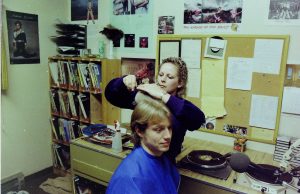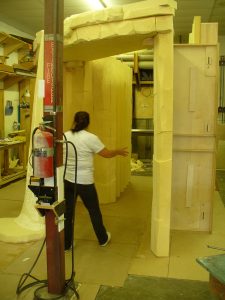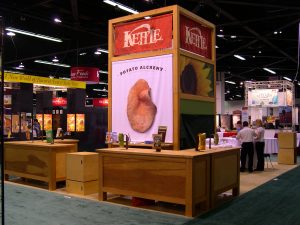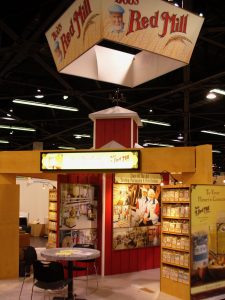Most of my blog posts are about the industry: how to do things, what works and what doesn’t, what’s new in the tradeshow world and so on.
But I rarely get personal on this blog. It’s not necessary, but on occasion it is kind of fun for readers to see who’s behind it all. Given that, I thought it would be worth it to explain exactly how I got here, and how I run my business.
Radio Daze

I spent 26+ years in the radio industry as a DJ, Music Director, News Director/Anchor, Program Director (and more), but as the industry changed (technology, mainly), I found that positions in the industry were getting squeezed, and a lot of talented people were having a hard time finding a spot. I loved radio – still do, in fact, as a volunteer doing a weekly two-hour reggae show on KMUZ in Salem – but to make a living in radio just wasn’t feasible anymore unless I wanted to be a gypsy and take my small family with me to where the jobs were at any given time. No thanks, I like Oregon and want to stay.
The Exhibit World is a Thing?
As to how I got to the tradeshow world, I literally stumbled into it. With two young sons, I was working as an assistant manager trainee for Hollywood Video, when a family friend’s wife saw me at the checkout counter.
“What are you doing here?”
“Training to be an assistant manager!” I said proudly (biting my tongue and crossing my fingers behind my back).
The next day her husband called me.
“I have an opening for a sales position at my exhibit company. How would you like to talk about it?”
Exhibit company? What’s that?
“Sure,” I said. Couldn’t hurt. Might even be interesting.
We sat down a couple of days later and chatted for an hour. Ed Austin, the owner of Interpretive Exhibits, talked about the exhibit industry – both interpretive and tradeshow – and how their small company fit. As the hour drew to a close, Ed Austin, the owner of the company, offered me the job.
“I didn’t really plan on offering you a job at this point, but you have good people skills, a lot of other good skills, and we can teach you about the industry.” His offer doubled the money I was making at Hollywood Video, so it was a no-brainer. Exhibit industry, here I come! Hollywood Video, by the way, was a victim, like Blockbuster Video, of the revolution in streaming video.
Learning the Exhibit World and Changing Careers
For the next several years, I slowly learned the exhibit industry. The biggest cultural shift and change to my daily work was the fact that in the exhibit industry, compared to the radio world, things moved slowly. Glacially. In the radio world, I’d get an order to write and produce a handful of commercials, due in a day or two. Three or more days if I was lucky. Once you got the order submitted, you had to jump on it. Or in the case of news reporting, it was non-stop. You were always hopping to find the next story, or to get the latest on a story that was active.
I found that in the exhibit industry, though, especially when it came to interpretive exhibits, there were usually a lot of parties that needed to chime in on something. Once a discussion or meeting was complete on a topic, the next step was usually weeks away before anything was due.
Weeks! Sometimes a month or two, before the next step was due, and the various parties had to chime in. I couldn’t believe it. I was so used having to jump, it took a long time to adjust to the glacial speed at which interpretive projects unfolded. In a sense, I found it boring, because I was always looking for something for my ADD brain to do (more on that later).
We did projects for the Army Corps of Engineers, National Forest Service, Oregon State Parks and many other government and non-profit agencies. An earlier salesperson had ended up selling a large exhibit to a large corporation, and the company knew there was business to be had there, but frankly, corporate work was foreign to the management. They were used to going onsite to a muddy natural area and chatting with like-minded people. They were not used to putting on a nice sport coat and meeting potential tradeshow clients.
Which became my task: find some tradeshow clients. Sell some tradeshow exhibits. Get on it.
What’s VP of Sales and Marketing Do?

After a few weeks at the company, it came to my attention that the company website sucked. Given my need to have something useful to do (I knew almost nothing about sales at that point), and since I had put up a handful websites, I offered to at least oversee a makeover of the website. Which I did, which they loved. And with the title of VP of Sales and Marketing, I was given free time to do things other than just sell exhibits. I also knew that I needed more information on the industry, so using my radio skills, I set up interviews with industry consultants, writers and experts. The interviews were recorded and posted on the website (this was before podcasting was invented – I just found a way to embed the audio). I also wrote articles based on things I had learned and posted them on the website (again, this was before blogging software found its way into the world).
I eventually compiled about an hour worth of recordings and created an audio CD which I gave away, calling it something like Inside Secrets of Tradeshow Marketing. I put it on the company site for something like $79, but where it was really useful was giving it away to potential clients (complete with a $79 price tag).
The First Exhibit Sale

As for tradeshow exhibits, I had a friend at Kettle Foods in Salem (employee number 8, I think), and asked if they did any tradeshow marketing. Turns out they did. Turns out they were shopping for a new one. We made a pitch, and they spent $25,000 on a 20×20 custom exhibit that made its debut at Natural Products Expo West in 2003. Ed told me years later that the $25,000 job cost the company about $40,000, so it was a money loser. But we kept showing it off and it kept leading to new clients, so I figure it paid for itself many times over.
In any event, we were off and running.

The Kettle Foods exhibit led to a connection with Nancy’s Yogurt (10×20 custom), Hyland’s Homeopathic (10×20 custom, which was designed, fabricated and shipped in 35 days flat, I kid you not!), and Bob’s Red Mill (custom 20×20). We did a custom 30×70 for local spa manufacturer Marquis Spas. We did exhibits for Mountain Rose Herbs of Eugene (still one of my favorites), BioKleen of Vancouver. The most interesting sale I made, though, was on a flight back from DC to Portland. I was catching a connection in Denver, and the woman next to me ended up sleeping most of the way back from DC to Denver. As we were coming in to Denver, she woke up and we chatted a bit. I asked what she was doing in DC and she said she had been at Expo East. I had too! I told her what I did, she took my card, I got hers, and a short time later we did a new custom booth for Natracare, from England, but with American HQ in Denver. It proved to me that there are opportunities everywhere if you keep your eyes and ears open and aren’t afraid of piping up.
Somewhere along the way, an old radio friend has asked me what I was doing now. “I’m in the tradeshow world!” I told him. He said, “Oh, you’re a Tradeshow Guy, eh?” Somehow that name stuck. In late 2008, I was curious about the new whiz-bang online publishing platform of blogging, and started TradeshowGuy Blog, just wanting something to play around with and as a creative outlet. It’s been going ever since.
The Coming End of Interpretive Exhibits
The recession in 2008/2009 did a number on the tradeshow exhibit building world. Many companies that we knew of in Portland closed. Others consolidated or downsized. Interpretive Exhibits’ secret weapon, I thought, was that we were small. We managed to keep a handful of people on salary and bring in the fabricators when projects warranted.
But Ed was nearing retirement, and in 2010 told us that he would close the company down in 2011. Which he did on July 15, 2011. My last day at Interpretive Exhibits.
What next? Another Career?
Not really knowing which way to turn, I thought I’d keep in touch with some old clients while I collected some unemployment, took some time off, and looked for another job. Which I figured I would get at some point.
But it never happened. Being in your mid-50s and looking for a new job is not a fun exercise to say the least. And along the way, I did have some previous clients order some new things. Not a lot, but enough to make me think that I should stick with this entrepreneurial thing.
In the meantime, prior to Interpretive Exhibits closing down, I had teamed up with Roger Pike, an old radio friend in town. We had shopped ourselves around as public speaker trainers and social media consultants. We got a couple of clients, the biggest of which was a local employers association that hired us to do a twelve-week training for their presenters. This was in Roger’s wheelhouse (not mine), as Roger was (and is) a great public speaker and former college public speaking champion. Lots of fun, but as time went on I kept putting more of my energy into selling exhibits (which was about to turn more profitable), and eventually left the consultancy with Roger behind.
That’s because in 2012, Bob’s Red Mill decided that their current 20×20 was going to be phased out and would I be interested in helping them do a new 30×30?
Of course. I contracted designer Greg Garrett, whom I had known while working at Interpretive Exhibits, and had him create a design. Once the design was approved, I shopped it around to three fabricators, and Classic Exhibits in Portland ended up getting the job. Even though they were known as more of a modular ‘kit’ builder, they were stretching their wings and were hoping to become more known as a custom builder. This project suited that desire perfectly and they did a fantastic job on the booth if I may say so.
That job convinced me that I could make a go at owning my own company. Roger Pike and I had called our company Communication Steroids, figuring that it was clever enough and descriptive of what we were doing. I named my exhibit company Communication One Exhibits, not that clever or descriptive, but what the hell, I thought.
Over the next few years, 2011 – 2014, I did a couple of larger projects, many small ones and kept the mortgage paid and the mouths fed. And I found I was having fun working for myself. In fact, I really liked it.
TradeshowGuy Exhibits
By late 2015, I had mentioned to Mel White, VP of Business Development at Classic Exhibits, that I didn’t like the name Communication One Exhibits, and he suggested I use TradeshowGuy Exhibits, since I was the TradeshowGuy online anyway! After a little thought and discussion, I did away with the old name and brought in the new one.
I kept looking for ways to generate more leads, make connections with prospects, and show off my growing expertise in the industry. I had done a handful of speaking gigs, both while with IE, and with my own company, and while I liked it, none of it lead to any significant new clients. I finally put my head down and finished a book that I’d started on at least three times. The book, Tradeshow Success: 14 Proven Steps to Take Your Tradeshow Marketing to the Next Level, came out in late 2015, and I immediately used it as a ‘business card’ with potential prospects. It didn’t automatically get people to buy, but it was certainly something that almost no other exhibit house or exhibit salesperson could offer.
In 2015, I went back to doing webinars on a regular basis, even securing the URL TradeshowGuyWebinars.com. I did them monthly, but after a year decided that I wanted to do a more regular podcast, which led to the TradeshowGuy Monday Morning Coffee which launched in January 2017. My goal was to just BE THERE on a weekly basis, to talk about things that interested me in and out of business. I’d have guests, but the guts of the show didn’t ride on having a guest. I’ve had a lot of guests (you really should browse this blog to find them!), they were all terrific and had fun stuff to share. But I have as much fun putting short podcasts or mini-films together, too, when it seems right.
In 2016, I felt my sales skills – which had grown a lot since my entrée into the industry in 2002 – needed some help. I had joined Tip Club in Portland, a networking group run out of Brad Kleiner’s office in Wilsonville. Brad was a Sandler Sales trainer, and after learning more about what and how he taught, I joined his President’s Club weekly 2-hour sales training group for a year. Best sales training I’ve ever run across, and it gave me a great set of tools on how to prospect, uncover pain, close and service the deal. Rejuvenating!
Another item had come up a few times – the use of the name TradeshowGuy. Once someone asked me if I had trademarked it. Uh, no. I looked into, and found it surprisingly easy. And pretty reasonably priced, too. It took several months, but in late 2017 I got confirmation that the trademark went through. So yes, it’s registered now. I’m officially TradeshowGuy and the company is known far and wide as TradeshowGuy Exhibits.
As we reach the middle of 2018, I look back and see that I’ve been running my own business for seven years now, and it’s doing better than ever. It’s not easy, it’s not predictable, but it’s been rewarding and fun. And I really do work at it. I like working with clients – that’s probably the most rewarding thing, seeing their reaction to a brand-new exhibit that will go out into the public and represent their company, products and brand. Great feeling.
They say that the best way to sell your book is to write another one, so in late 2017/early 2018,I compiled several dozen lists that had been published on this blog and released my second book, Tradeshow Superheroes and Exhibiting Zombies: 66 Lists Making the Most of Your Tradeshow Marketing.
Who knows how far this thing goes? I figure if I can get another seven years out of the business, I’ll consider closing it down. After all, I’ll be 70, and may want to do other things. But hey, I still jam on my guitar, still bash my drums regularly, do a fair amount of hiking, bicycle riding and walking. I’m planning to live to be 120, so I have a way to go, amiright?

